From spending the last 7+ years developing recipes, I have attempted my fair share of vegan chocolate recipes. When it comes to dairy-free chocolate bars I've tried versions that were too oily, not sweet enough, too bitter, too fudgy, and too soft. This vegan milk chocolate recipe, however, is by far the closest thing to that milky-tasting dairy chocolate I've ever made.
In this post, I'm going to take you through two different methods for making your own vegan milk chocolate at home. Using real cacao nibs, or using cacao paste with minimal equipment.
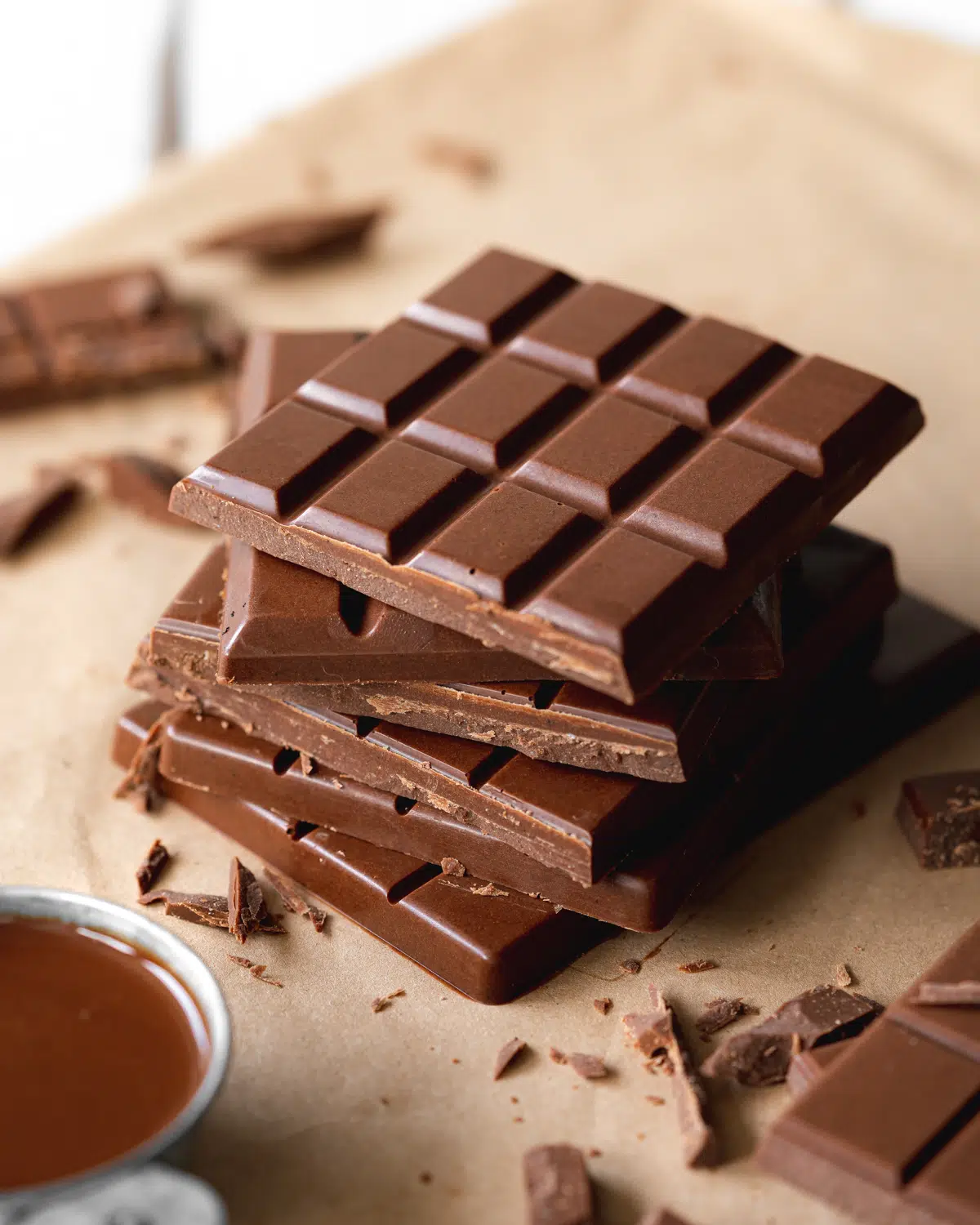
Jump to:
📖 Recipe Overview
Chocolate is usually made with a wet grinding machine (melanger). But grinders can cost a couple of hundred euros and aren't something you'd typically find in most kitchens.
So I wanted to create a recipe that anyone could try at home, without having to dish out buying expensive equipment that you might not necessarily get a lot of use out of. Here's what you can expect from this recipe:
- Delicious Taste - With a cream "milky" coconut flavor.
- Solid Texture - Chocolate that "snaps" and isn't soft or fudgy.
- Versatile - This chocolate melts beautifully and can be used as the base of many vegan chocolate desserts. These dairy-free chocolate bars also make a great gift, you can get creative by adding nuts and flavorings to them as well.
- Made With Real Cacao - This recipe uses a combination of cacao base ingredients to create a delicious chocolate bar.
- Allergy-Friendly - Not only is this chocolate dairy-free, but it's also naturally gluten-free and has a refined sugar-free option.
If you're a chocolate lover like me and are looking for more vegan chocolate recipes, you can also find an entire chocolate chapter in my cookbook No-Bake Vegan Desserts.
🧾 Ingredients Needed
As mentioned you just need 6 ingredients to make delicious homemade dairy-free chocolate. Here's what to grab:
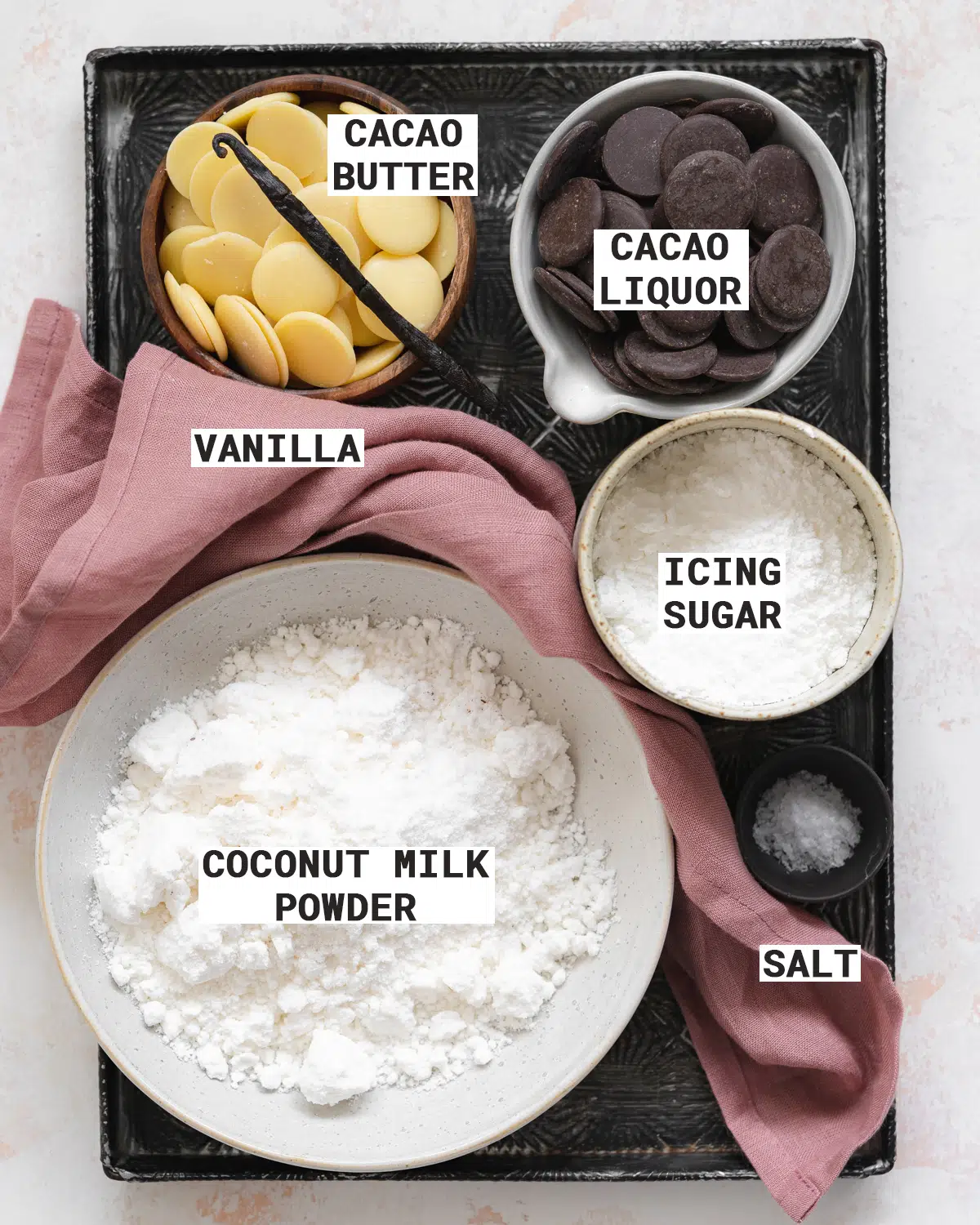
Ingredient Notes
- Cacao Liquor - Also known as cacao paste, is pure cacao mass in solid form. It's usually available in the form of buttons/discs. Although they may smell and look like chocolate buttons, I don't recommend tasting them as is, they are super strong and bitter (tempting, I know). You can also use cacao nibs and make your own cacao paste by roasting them and grinding them down, although you will need a good-quality blender for this method. I know it can sometimes be challenging to get your hands on cacao liquor, so in this case, the cacao nibs method may be more accessible.
- Cacao Butter - This is the fat that's derived from the cacao bean. Again, it's usually available in the form of buttons or in a solid block.
- Powdered Sugar - Personally I find that icing sugar (confectioner's sugar) gives this vegan milk chocolate the smoothest texture. But if you want to keep the chocolate refined sugar-free, you can use coconut sugar. Simply grind down the coconut sugar into a powdery consistency for the smoothest consistency of chocolate.
- Coconut Milk Powder - Be careful to choose a brand that's 100% coconut milk powder, as some coconut milk powder brands have fillers and dairy snuck into them!
- Vanilla - I recommend using a real vanilla pod here, vanilla extract or bean paste will add unwanted moisture to your chocolate bars.
- Sea Salt - This enhances the flavors and balances the sweetness of the chocolate.
🥣 How To Make Dairy Free Chocolate
Find the complete list of ingredients, quantities, and instructions in the recipe card at the end of this post.
Method 1: Using Cacao Paste
This is the simpler method as you can avoid having to roast and blend the cacao nibs. Here's how it's done:
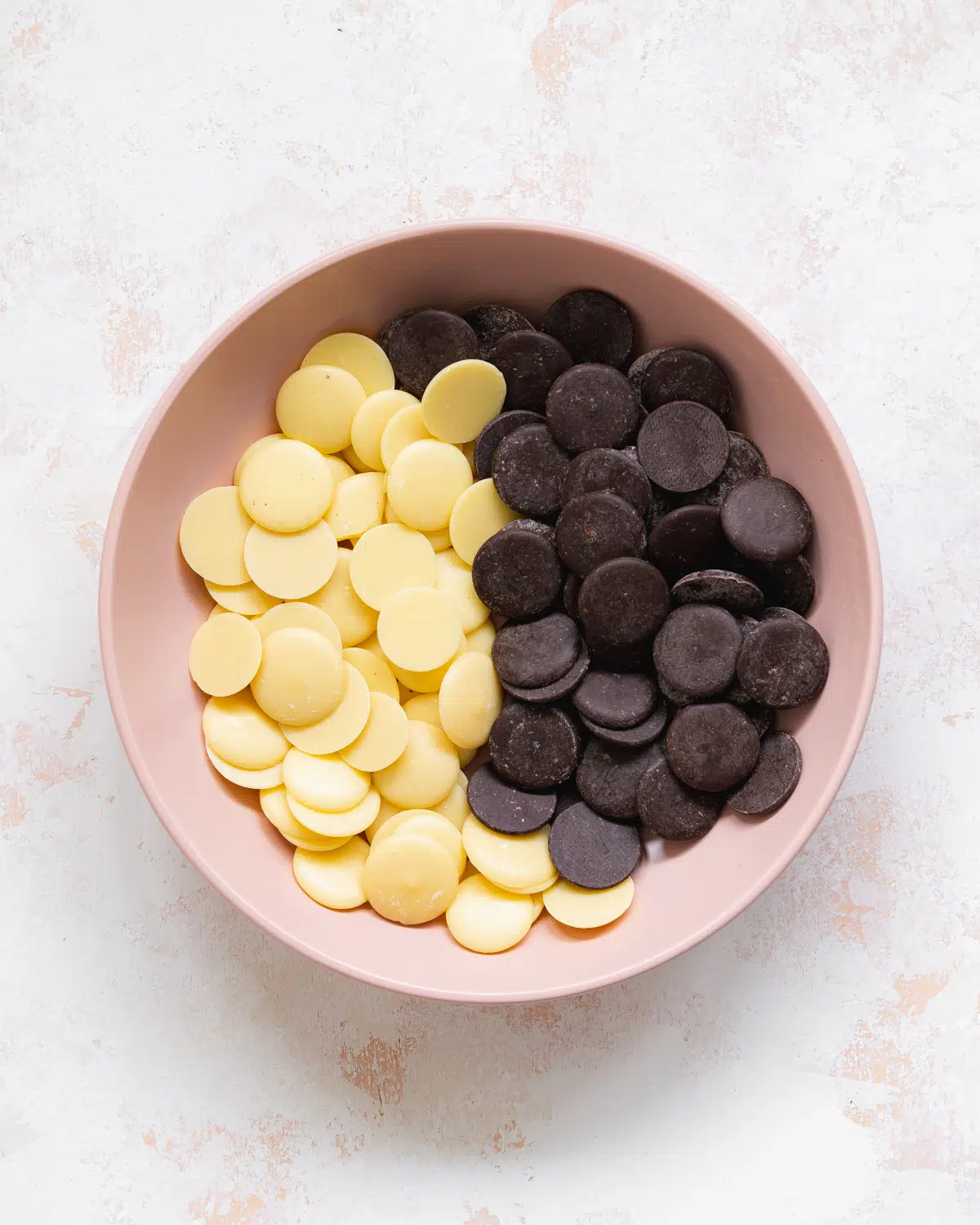
Step 1: Set up a water bath. Add the cacao liquor and cacao butter to a large heat-resistant bowl and place on top of a saucepan with simmering water (known as a bain-marie or water bath). Make sure the water does not touch the bowl.
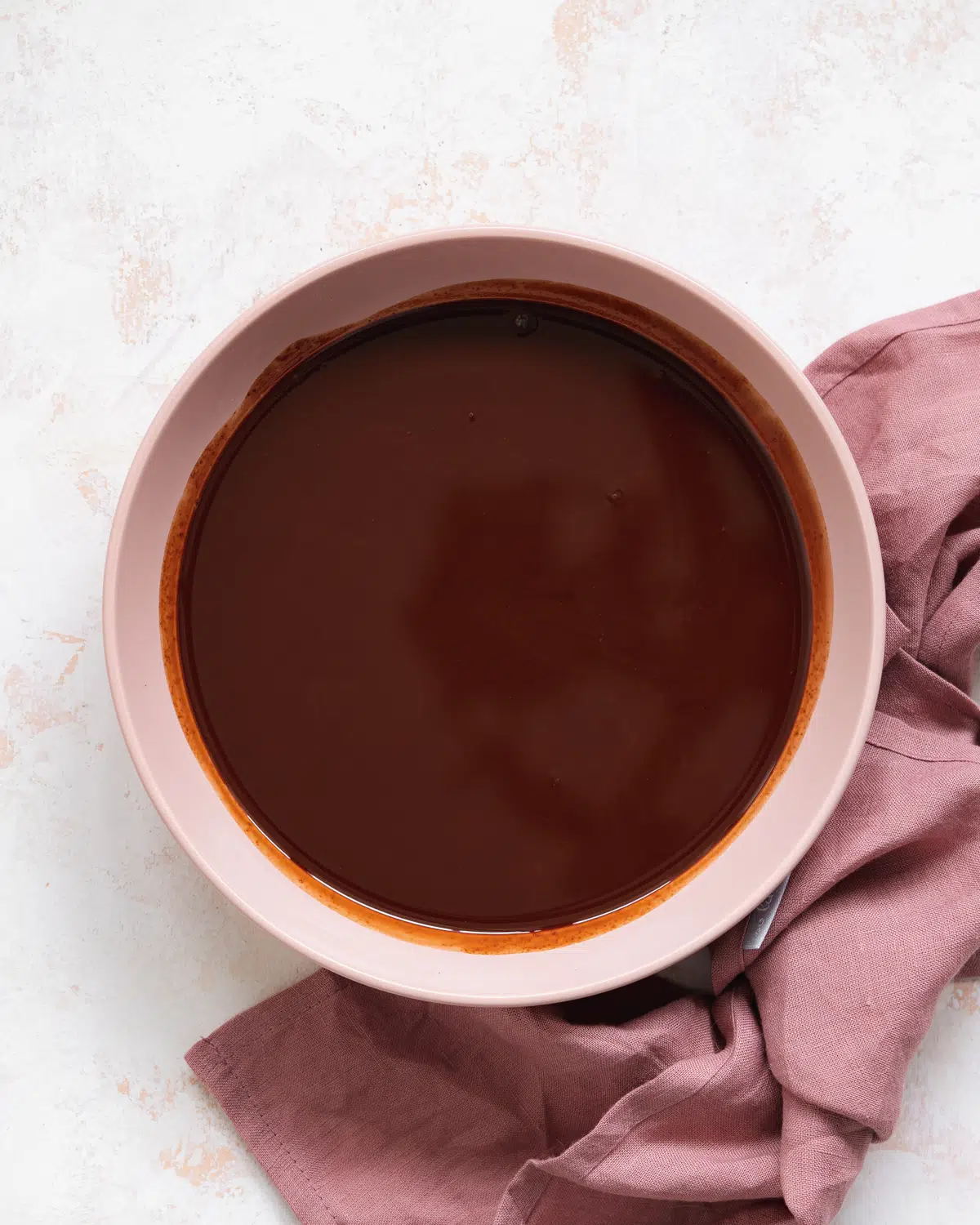
Step 2: Melt. Turn the heat on to medium-low and allow the steam to rise up and gently melt the ingredients. Be careful that absolutely no water splashes into the bowl as water will cause the chocolate to seize.
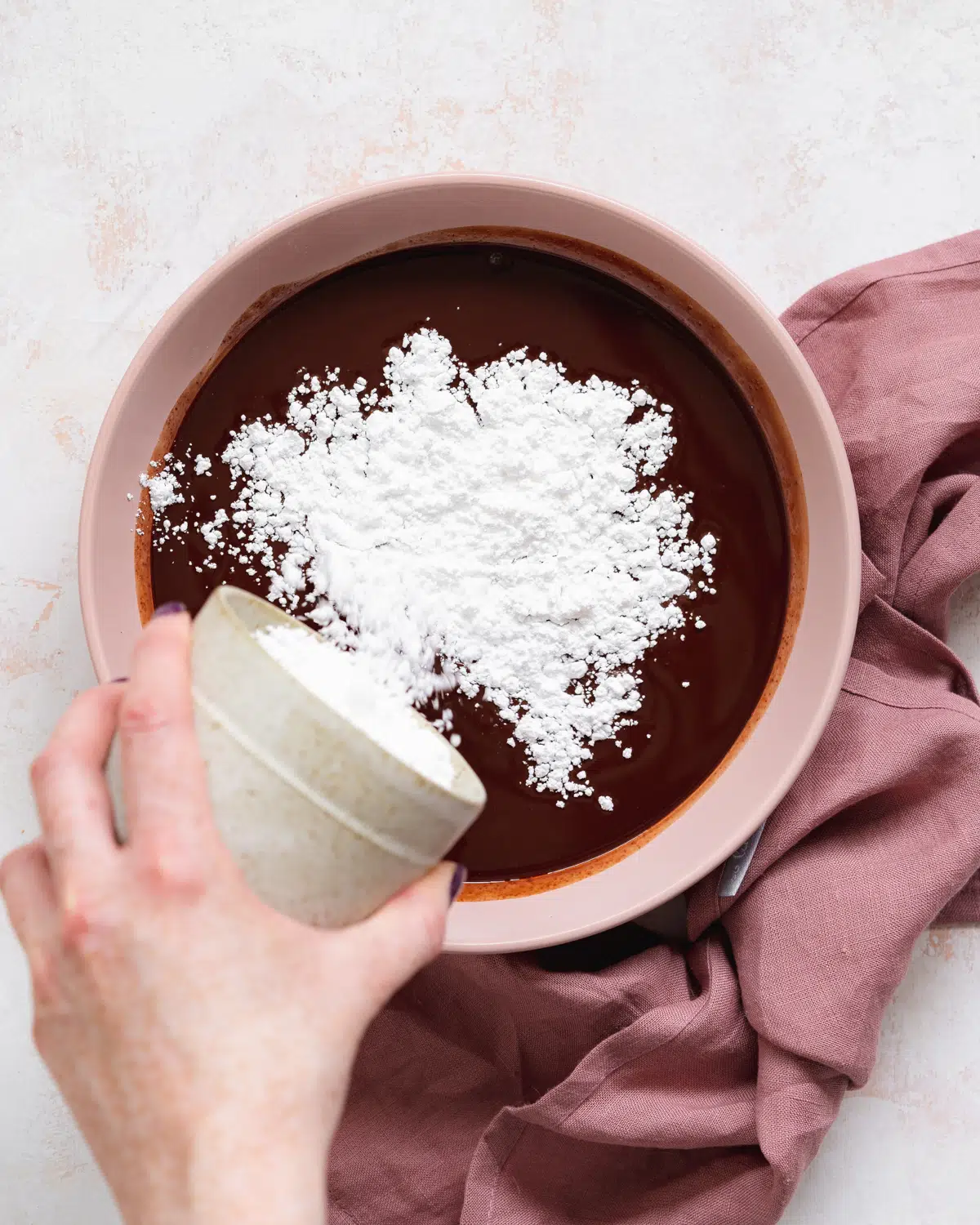
Step 3: Sweeten. Remove the bowl from the water bath, making sure that no water accidentally splashes into the chocolate. Add the powdered sugar and whisk until incorporated into the chocolate mixture.
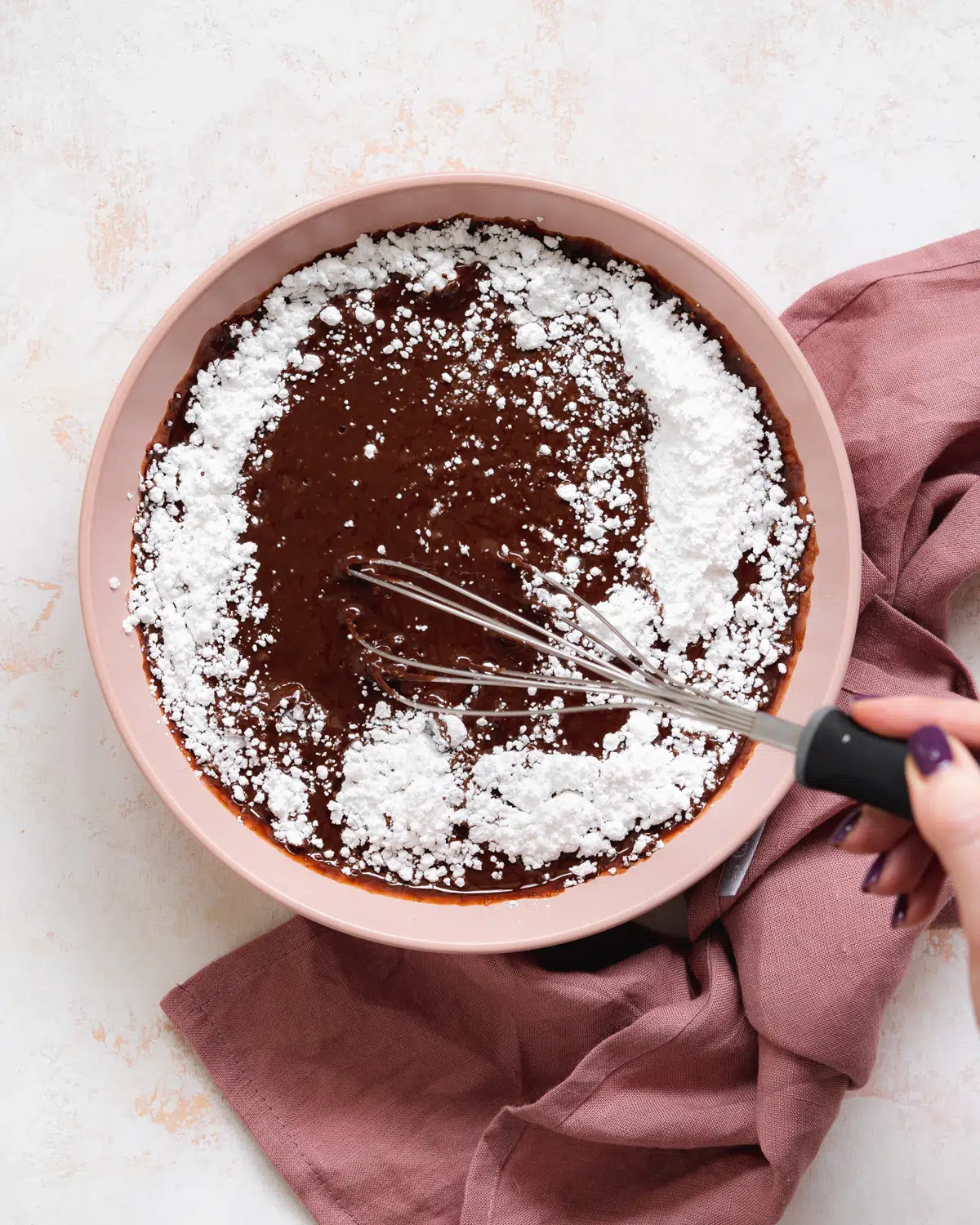
Step 4: Flavor. Add the coconut milk powder, salt, and vanilla and whisk again until the ingredients are evenly mixed.
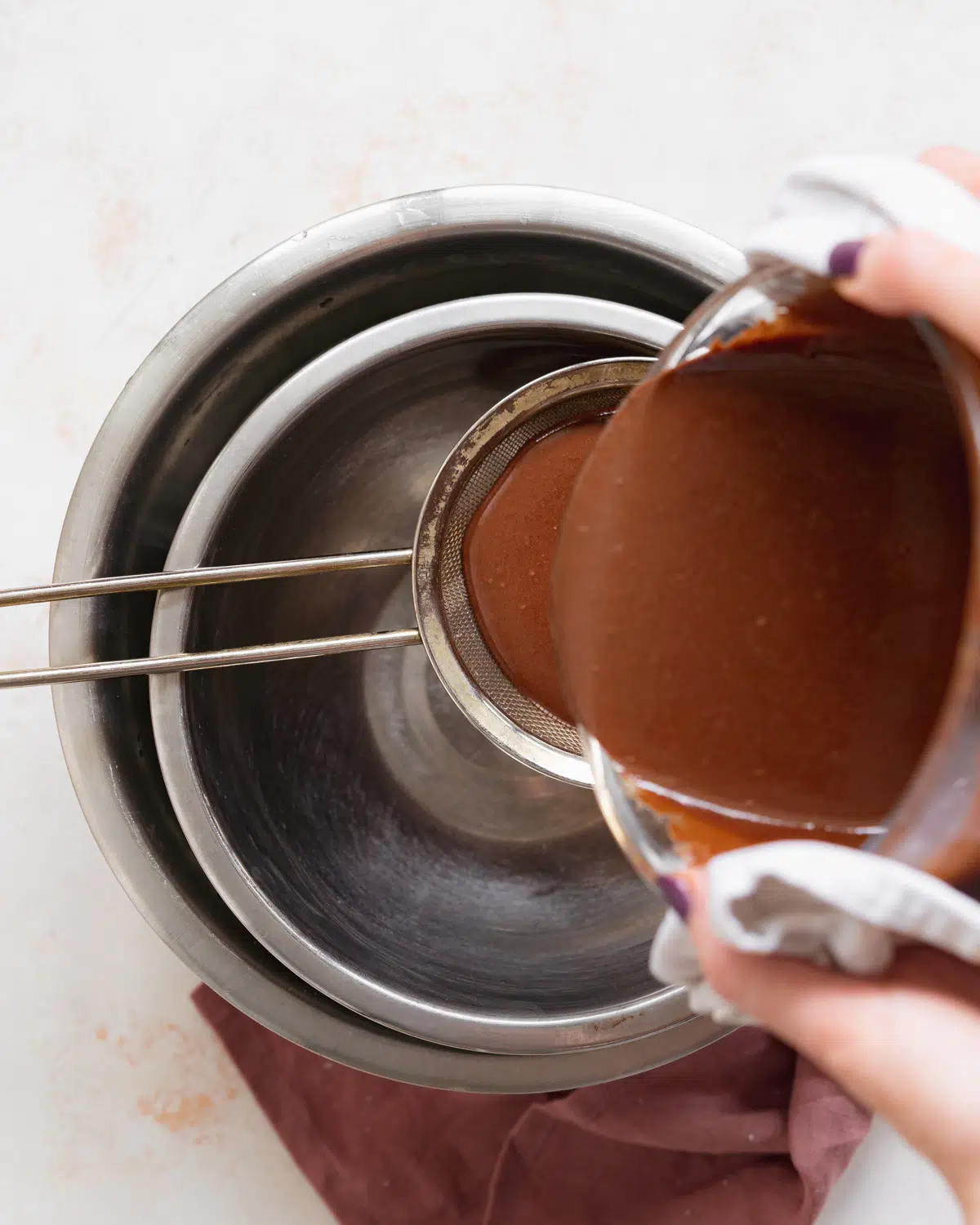
Step 5: Sift and temper. Place the bowl back on the water bath and place a thermostat into the bowl of chocolate to measure the temperature. Bring the temperature up to 50°C (122°F). Remove the bowl from the heat and pass the chocolate through a sieve into a clean bowl. Make sure you dry the bottom of the bowl so that no water/steam gets into the chocolate while transferring it to a new medium-sized bowl.
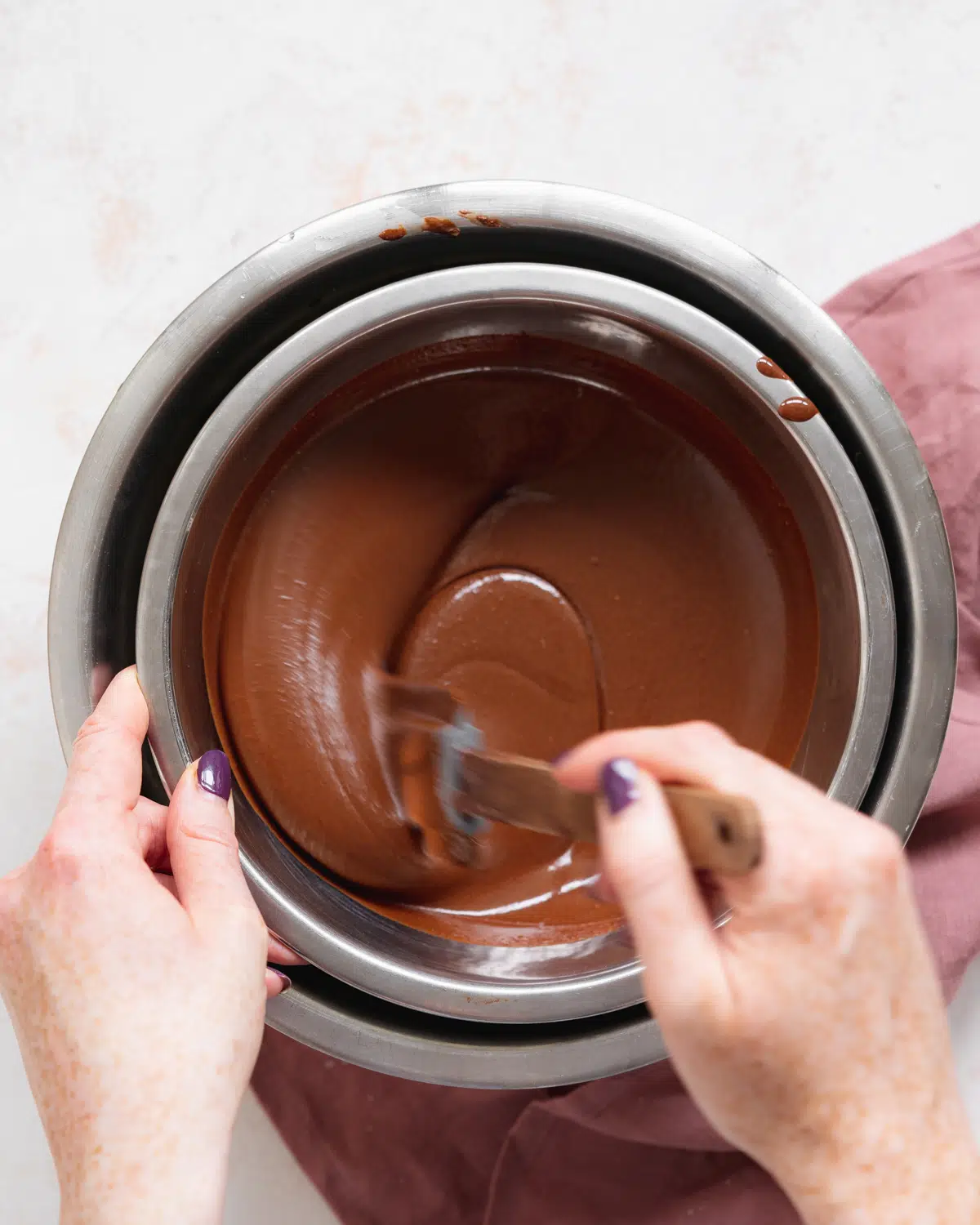
Step 6: Continue tempering. Set the bowl of chocolate on top of an ice water bath, making sure no water can splash into the chocolate. Gently stir the mixture with a spatula until the chocolate temperature reaches 28°C (82.4°F). Then, place the bowl back on top of the water bath and bring the temperature back up to 30°C (86°F).
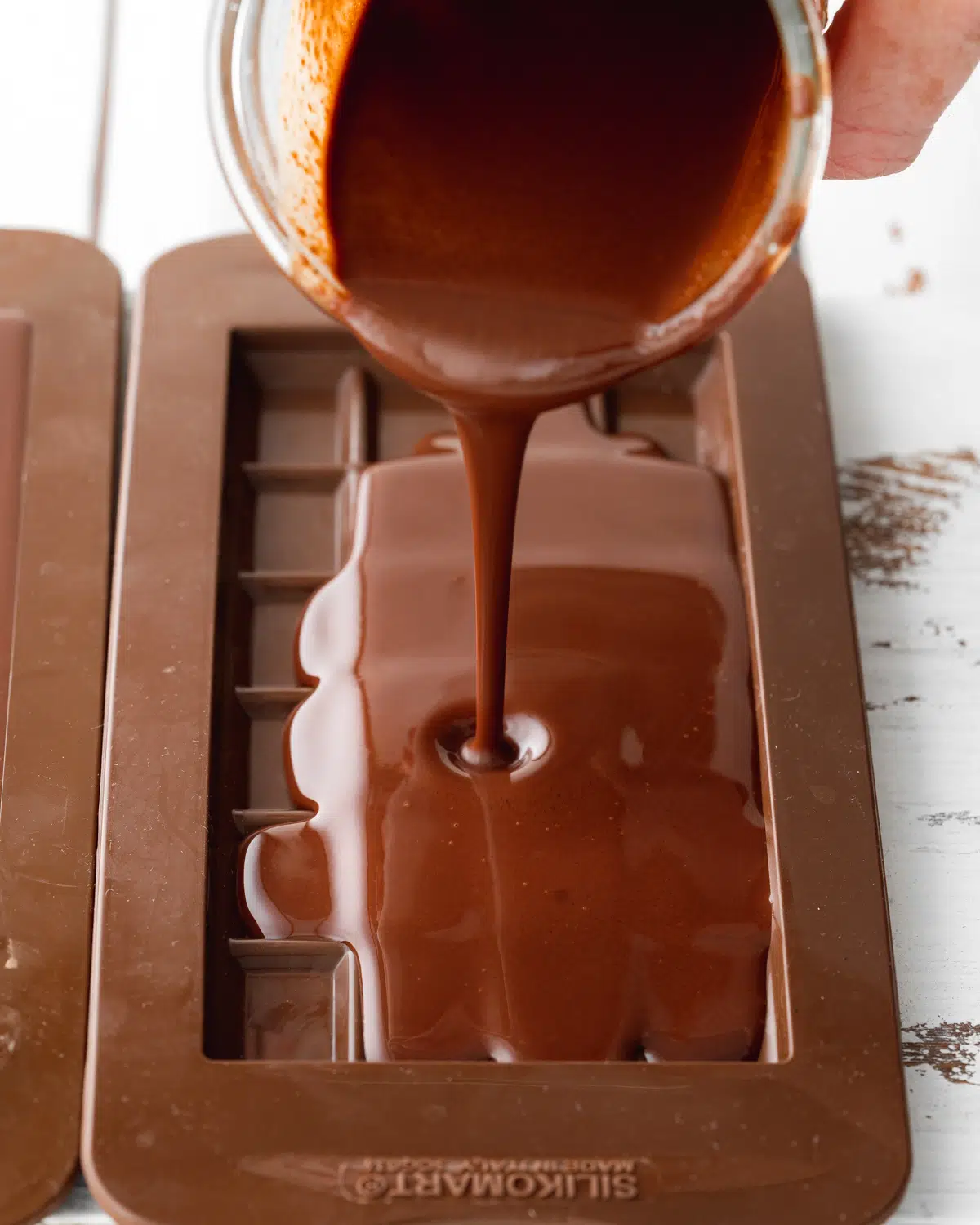
Step 7: Mold and set. Divide the chocolate into the silicone molds and place it in the fridge to chill for at least 20 minutes. This recipe will make 5 large bars.
Method 2: Using Cacao Nibs
In this method, the main difference is you'll be using cacao nibs and making your own cacao paste. This extra step will involve roasting the cacao nibs until they're toasted and smelling fragrant and then blending them into a paste.
I find the best way to get them into a paste is to add the solid cacao butter to the blender with the nibs as they will melt down really fast once blended and help to keep the ingredients from sticking too much to the sides of the jug.
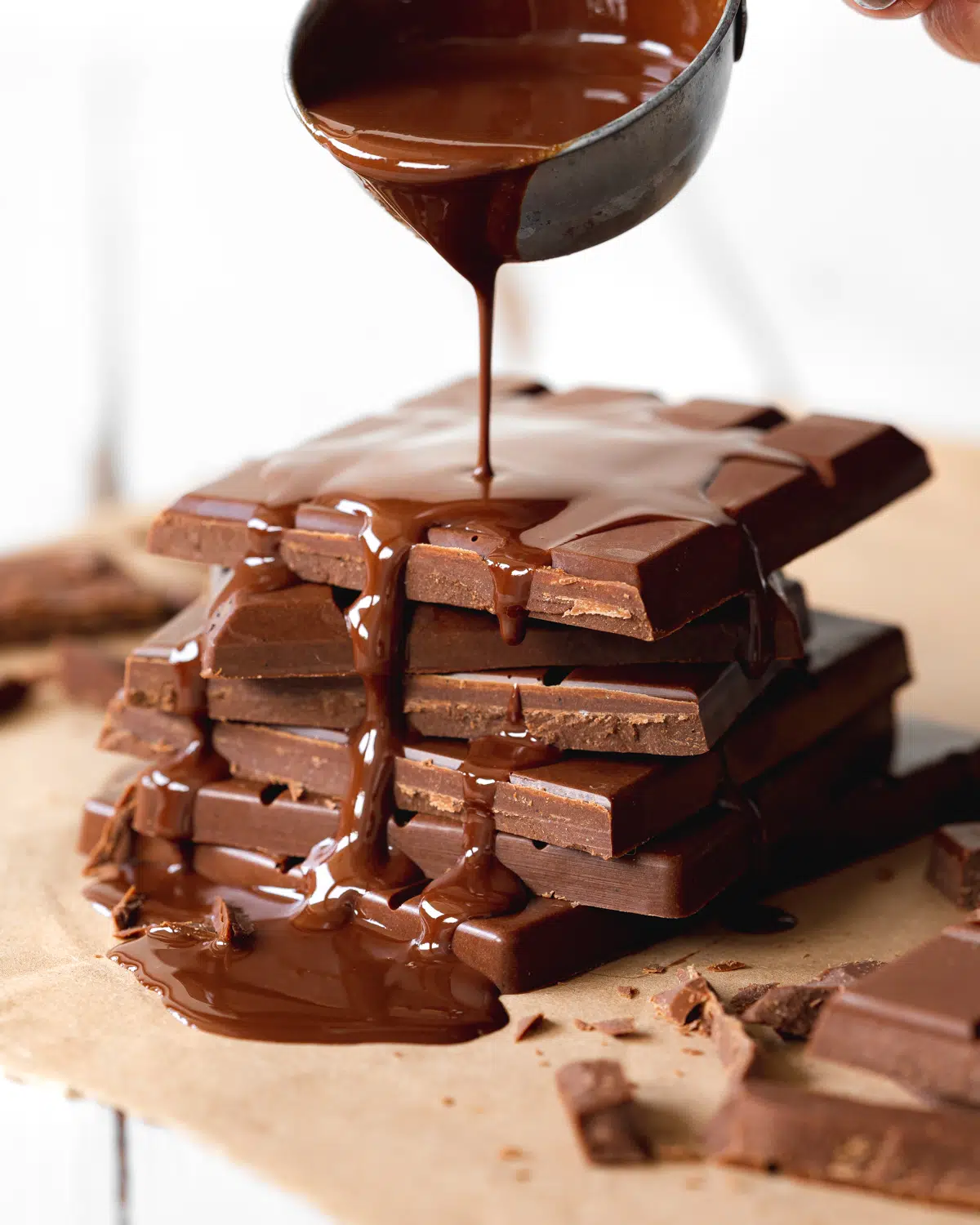
📝 Recipe Tips
1. Prepare Your Equipment
It kinda goes without saying, but for this recipe in particular it is important to have all your bits and bobs ready to go. The last thing you want is to be fumbling around trying to get a water bath ready mid-chocolate making! So read the recipe, read it again, and get all of your equipment and ingredients prepped in advance.
2. Avoid Water & Liquids
Water, and any other liquid that is. Traditional chocolate recipes are based on fats. If the liquid is added to the mix this will cause the chocolate to seize. Basically, your beautiful shiny chocolate will go dull and clump together.
Although you may be able to recover seized chocolate by adding more liquid, at this point it will be like ganache or fudge, and won't set like regular chocolate. So remember, the most important thing when creating a chocolate recipe is to AVOID LIQUIDS at all costs.
3. Use Powdered Sugar
It's also a good idea to avoid using liquid sweeteners such as maple syrup or agave. The key is to use sugar that has a very fine powder consistency such as icing sugar. Using granulated sugar will give your chocolate a gritty texture, as sugar crystals need water to dissolve (which we're avoiding in this chocolate recipe).
For a refined sugar-free option, I recommend using coconut sugar that has been blended down into a powdery consistency. This step will take a little patience, but it will be totally worth it to give you the smoothest consistency possible for homemade chocolate.
4. Temper The Chocolate
Have you ever wondered why some chocolate is shiny and snaps when you break off a piece? The shine in chocolate is traditionally created by "tempering" which is the process of melting and cooling chocolate in order to form beta crystals in the cacao butter.
Some cheaper brands of chocolate skip this method and coat chocolate with shellac, which is a resin secreted by the female lac insect! If you've ever considered tempering chocolate before, chances are this may be something that you have avoided thinking it was a task only cut out only for master chocolatiers.
I am 100% guilty of this, and although I'm not going to sit here and lecture on the correct way to temper chocolate, as it is very much an art and I still have a lot to learn, in the below recipe I will share with you how I was able to get a nice shine and snap from the chocolate without too much effort by a using a method referred to as "the seeding method".
This article on how to temper chocolate by BBC Food goes into more detail.
🍽 Serving Suggestions
There are so many ways to use homemade dairy-free chocolate, here is just some of the endless applications:
Candy Bar Coating - Use it to coat homemade vegan chocolate bar recipes such as Snickers, Crunchies, Toffee Crisp, Mars Bars, Butterfingers, Twix, Reese's, Ferrero Rocher, Creme Eggs, or Bounty Bars.
Chocolate Fruit - Use to coat fruit like this Chocolate Strawberry Bouquet or as a chocolate fondue for dipping fruit.
Frostings - Use it in Chocolate Frosting, Swiss Buttercream, or Chocolate Ganache
Chocolate Desserts - For Mousse Au Chocolat, Chocolate Cheesecake, Chocolate Tart, Biscuit Cake, or Brownies.
Cookies - It's no secret that I love adding both chocolate chunks AND chocolate chips to cookies. Feel free to roughly chop your dairy-free chocolate and add it to CC Cookies, Choc Hazelnut Cookies, or Pumpkin Chocolate Chip Cookies.
Chocolate Topping - Melt it over vegan ice cream sundaes, this would be so good poured over Chocolate Ice Cream or Vanilla Ice Cream.
📔 Optional Variations
- Soy Milk Powder - To make this vegan milk chocolate without coconut you can try soy milk powder. I personally haven't been able to test this one yet as it's pretty difficult to find here in Ireland but I'd love to know how it went if you give it a go.
- Nuts - You can get as creative as you'd like with these chocolate bars. Try adding nuts such as roasted hazelnuts, and chopped almonds, or go for a fruit and nut bar by adding cranberries and raisins.
- Coconut - Add some shredded toasted coconut to the chocolate before setting for a delicious coconut milk chocolate bar.
- Flavorings - Add a couple of drops of oil-based flavoring such as mint, orange, lemon, or rose.
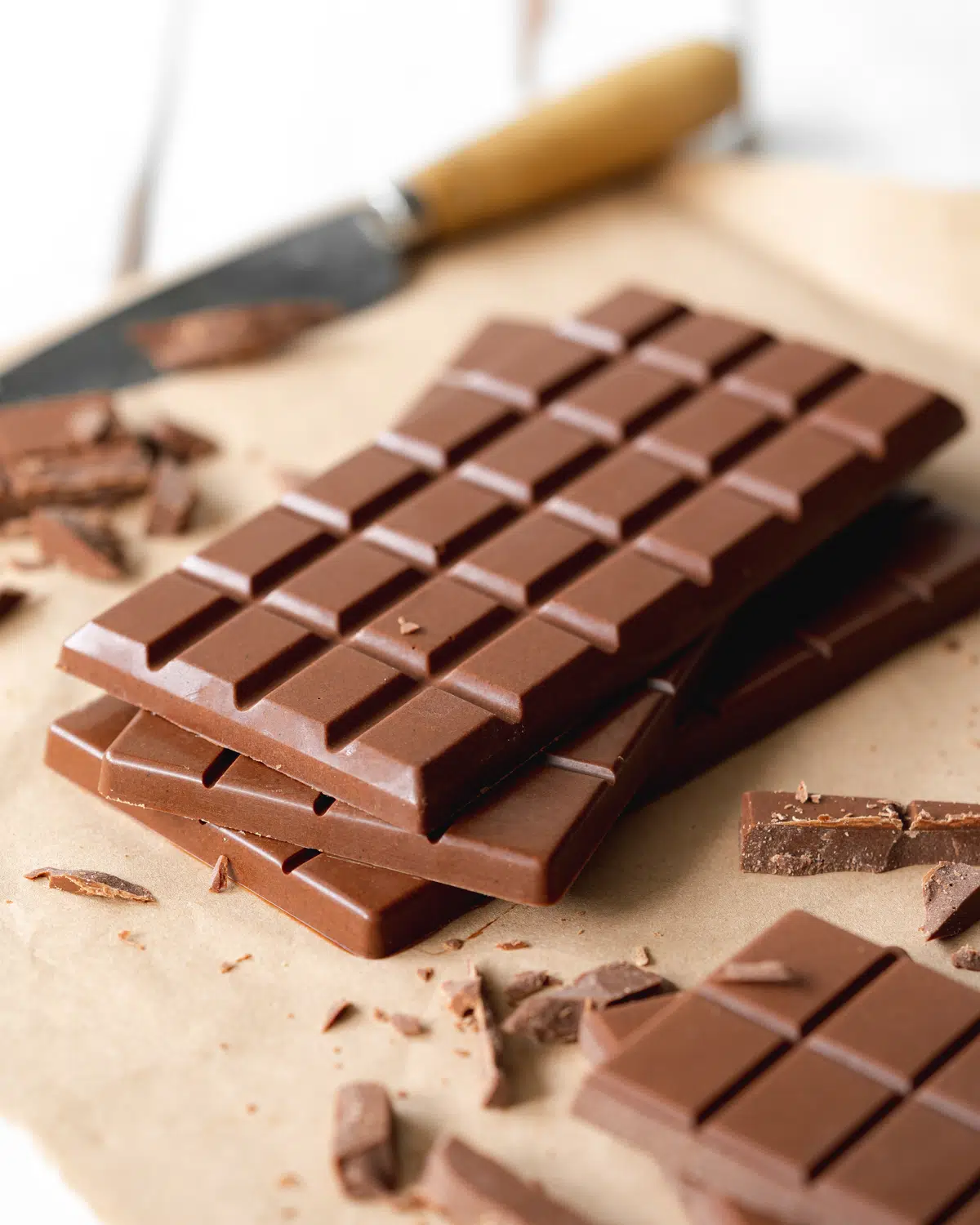
💬 FAQs
With this recipe, I opted to use cacao nibs, roasting them from scratch instead of using cacao powder as I did in all my previous recipes. The cacao nibs contain both cacao solids and cacao butter. Dry cocoa solids are the components of cocoa beans remaining after extracting the cocoa butter, the fat component. When roasted and blended the cacao nibs convert into a liquid state or cacao paste, otherwise known as cacao liquor.
Personally, I have found that the chocolate made using cacao nibs blended into a paste sets better than when using a combination of cacao powder and cacao butter.
There is also something very therapeutic about smelling freshly toasted cacao nibs, similar to roasted coffee beans, the scent will fill up your house so beautifully that you may mistake your kitchen for Willy Wonka's factory!
Remove the bars from the molds and wrap them in baking paper and place them in an airtight container.
I recommend storing them in the fridge as they can get a little soft if left out at room temperature for periods of time. They will stay fresh in the fridge for at least 2 weeks.
I highly recommend a candy thermometer, silicone chocolate molds and you will need a good quality high-powered blender if using the cacao nibs method.
🍫 More Vegan Chocolate Desserts

Love this recipe? Please leave a 5-star ★★★★★ rating in the recipe card below and consider leaving a comment as well, thanks!
Stay in touch with me through social media @ Instagram, Pinterest, TikTok, and Facebook. And subscribe via email to get all our new recipes!
Description
Equipment
Ingredients
- 6.3 oz (178 g) cacao liquor (cacao paste), or 1 ½ cups cacao nibs (see method 2 in the recipe instructions)
- 8 oz (226 g) cacao butter
- 1 cup (236 g) dairy-free coconut milk powder, can be found in most Asian speciality shops
- 1 cup (120 g) powdered sugar (confectioner's/icing sugar), or coconut sugar finely ground *see recipe notes
- 1 vanilla pod
- ½ teaspoon (3 g) Himalayan pink salt
Instructions
Method 1: Using Cacao Liquor/Paste
- Lay the silicone molds out on trays that you will easily be able to transfer to the fridge later. Cut the vanilla pod in half and scrape out the seeds with the back of a knife, and set the seeds aside for later. Discard the pod or use it to flavor other recipes.
- Add the cacao liquor and cacao butter to a large heat-resistant bowl and place on top of a saucepan with simmering water (known as a bain-marie or water bath). Make sure the water does not touch the bowl but allow the steam to rise up and gently melt the ingredients. Be careful that absolutely no water splashes into the bowl as water will cause the chocolate to seize.
- Remove the bowl from the water bath and add the icing sugar. Whisk well until the sugar has been incorporated into the chocolate mixture. Then add the coconut milk powder, salt, and vanilla and whisk again until the ingredients are evenly mixed.
- Place the bowl back on the water bath and place a thermostat into the bowl of chocolate to measure the temperature. Bring the temperature up to 50°C (122°F). Remove the bowl from the heat and pass the chocolate through a sieve into a clean bowl. Make sure you dry the bottom of the bowl so that no water/steam gets into the chocolate while transferring it to a new medium-sized bowl.
- Set the bowl of chocolate on top of an ice water bath, making sure no water can splash into the chocolate. Gently stir the mixture with a spatula until the chocolate temperature reaches 28°C (82.4°F). Then, place the bowl back on the water bath and bring the temperature back up to 30°C (86°F).
- Divide the chocolate into the silicone molds and place it in the fridge to chill for at least 20 minutes. Once set, remove the bars from the molds and wrap them in baking paper, and place them in an airtight container. Store in the fridge for up to 2 weeks.
Method 2: Using Cacao Nibs
- Preheat your oven to 120℃ (248°F). Line a baking tray with a silicone sheet or parchment paper and spread the cacao nibs out on top of it. Roast the cacao nibs in the oven for 10-12 minutes until they start to brown.
- Once ready, remove the cacao nibs from the oven and place them in your high-speed blender along with the cacao butter (you can add the solid buttons, or finely chopped if using block cacao butter). Blend, blend, blend! You want the cacao nibs to turn into cacao paste/cacao liquor. This should take approximately 5 minutes or so., depending on the quality of your blender. Once runny, pass the mixture through a fine-mesh sieve to make sure there is no remaining grit.
- Repeat all of the steps shown in method 1 at the beginning of the recipe instructions.
Video
Notes
- Powdered Coconut Sugar: Add coconut sugar to a high-speed blender and blend until ground into a powder, starting at low speed and increasing the speed. Scrape down the sides of the blender as needed. This can take 5-10 minutes depending on your blender, the consistency should resemble icing sugar.
- Soy Milk Powder: I personally haven't been able to test this one yet as it's pretty difficult to find here in Ireland but I imagine you could use it in place of coconut milk powder.
- You can get as creative as you'd like with these chocolate bars. Why not try adding nuts such as roasted hazelnuts, chopped almonds, or go for a fruit and nut bar by adding cranberries and/or raisins.
- Add some shredded toasted coconut to the chocolate before setting for a delicious coconut milk chocolate bar.
- Flavorings: Add a couple of drops of oil-based flavoring such as mint, orange, lemon, or rose.
Nutrition
© addictedtodates.com. All content and images are protected by copyright. If you want to share this recipe, please do so using the share buttons provided. Do not screenshot or republish the recipe or content in full. instead, include a link to this post for the recipe.
*This recipe was originally published on January 21st, 2019. The recipe has since been improved and was last updated on October 1st, 2021 to minimize the ingredients used and to simplify the instructions.

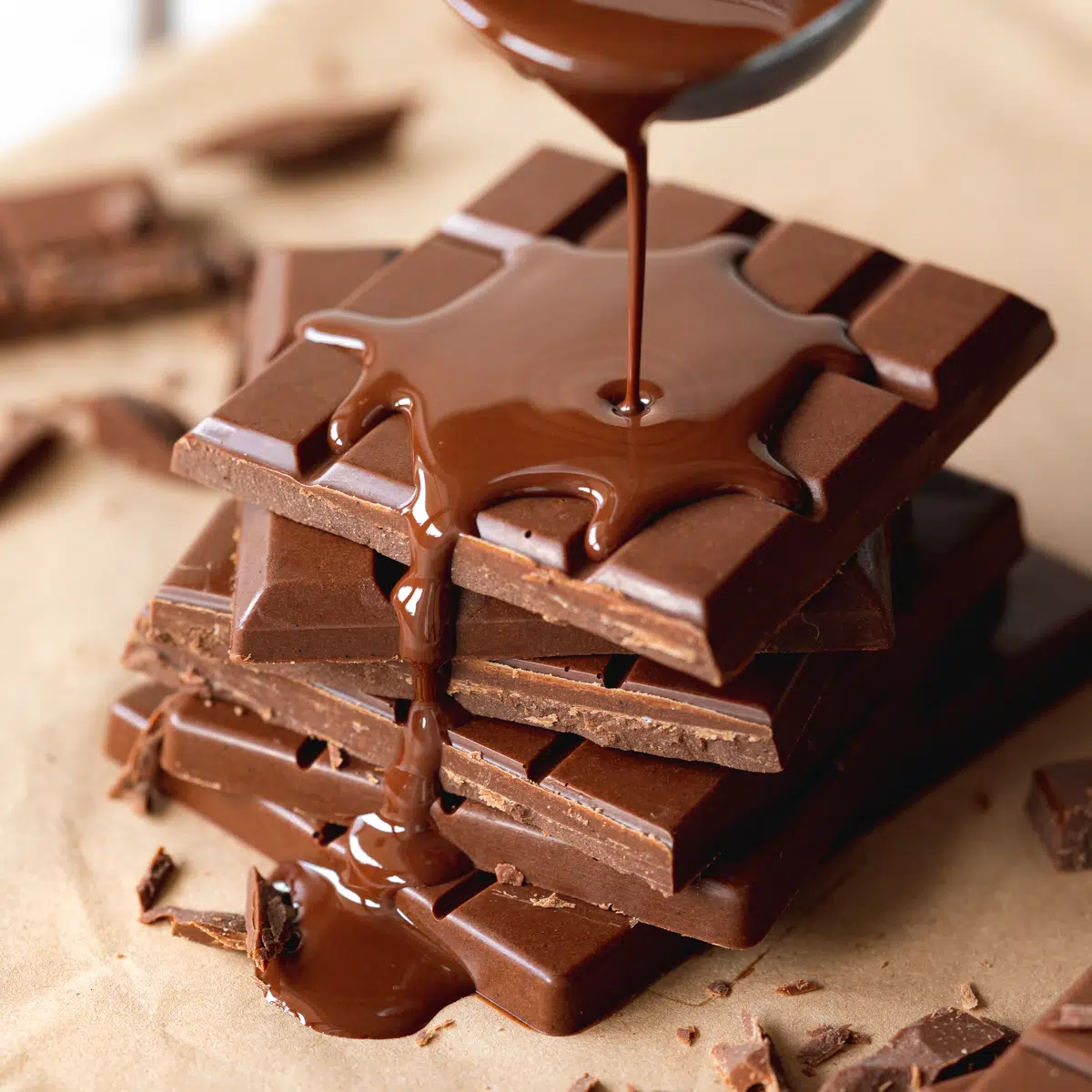
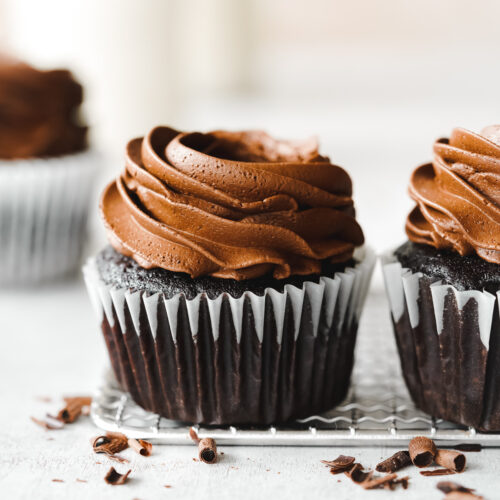
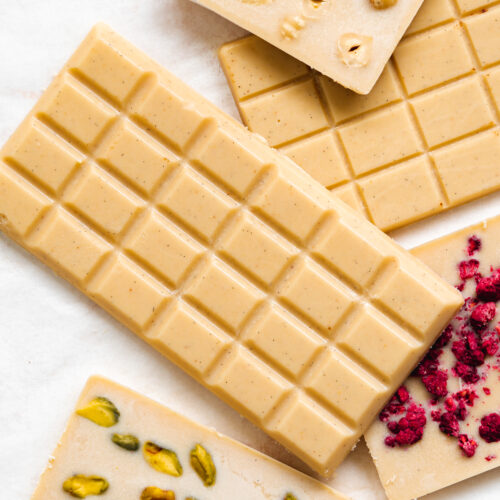
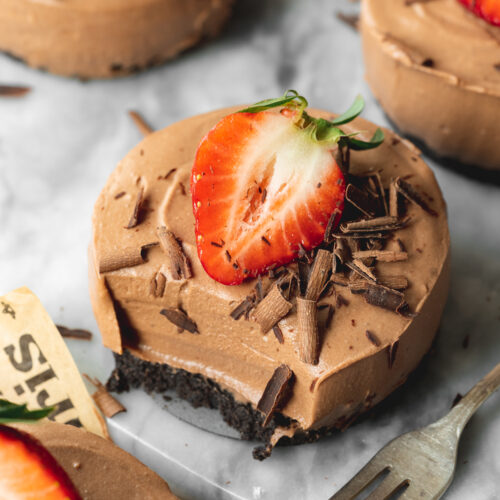
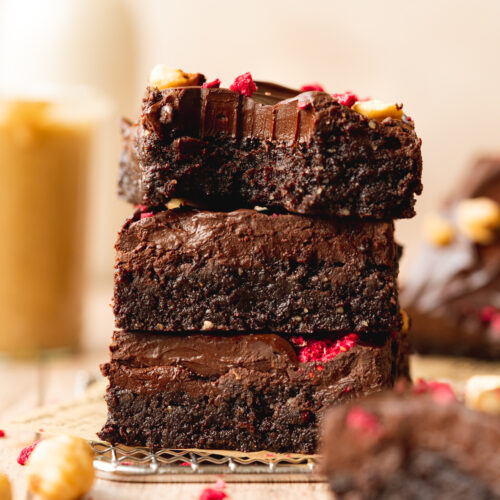
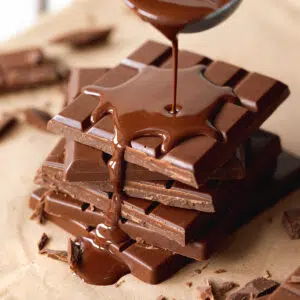


My Friend does not like coconut milk powder is there a substitute for that last time I make this recipe I followed the same steps above and the outcome is very good can you help me now and I want to ask you do you have a vegan chocolate lava cake recipe because I love that if I make that for my friend.
I must say, I absolutely adore this recipe! I recently tried it, and it turned out to be a true delight. The addition of vanilla extract and sea salt adds a delightful depth of flavor. I appreciate how versatile this recipe is, allowing for adjustments to suit personal taste preferences. On another note, I’m also a huge fan of vegan desserts. It’s incredible how you managed to create such a delectable treat without any animal products. Thank you for sharing this mouthwatering recipe!
Hi Wasif,
I'm delighted to hear you enjoyed the recipe - thanks for sharing your experience!
Hi! Thanks for posting this recipe and video. The video shows a blender with attachments and features I haven't seen before, particularly the one with the side scrapers built in ... What kind of blender is it?
Hello, you are so welcome, and thank you for being here 🙂 This was a JR Touch 3 blender with a cyclone attachment.
Hi,
I'm new to vanilla pods and was wondering if there's anything else I'm supposed to do with the seeds, or just put them in as is? (Like crush or grind them or something, or are they small enough without?)
I'll also be trying it with soy milk powder (hard to find milk free coconut milk powder in Japan), so I'll report back if it worked 🙂
Hi Kiri,
You can add them as is. Very interested to hear how it goes with soy milk powder! 🙂
Hi Christina,
I don’t have vanilla pods. Can I use vanilla extract instead?
Hi Sara,
I would suggest just leaving the vanilla out in that case, as you don't want to add any water-based ingredients to the mixture 🙂
I think the coconut milk powder made my batch SO gritty/grainy. Even after running through a sieve a few times, then food processing the liquid chocolate, there’s still too much texture. Is there a way to save the chocolate when gritty? I’m bummed because the ingredients were expensive, but I have something basically unusable 🥲
Hi Amalia,
Coconut milk powder should usually be very fine, which brand did you use? And what type of sugar did you use?
Hi Christina!
Sorry, I never saw your response, so here I am 2 weeks later! The coconut milk powder brand I used was "Earth Circle Organics" off of iHerb. I actually picked that one because some of the reviews mentioned it wasn't grainy compared to other brands (I'd tried Native Forest's coconut milk powder a few years ago, and that was always grainy for me too, so that seems to be the theme). Incidentally, I also got Native Forest's cashew milk powder in the same iHerb order as the other coconut milk powder brand, and it wasn't gritty, and dissolved for me when I tried it with some water! But the bag size wasn't enough to use in the chocolate recipe sadly.
As for sugar, I used powdered sugar from Domino, which I've never had a problem with. I could definitely feel the grit came from the coconut milk powder because the flavor stuck out a bit when it stuck to my teeth. I don't know why it still wouldn't incorporate after 10-15 min in the food processor (which was undoubtedly heating up the mixture too...I thought maybe it would finally dissolve with that extra warmth). It was struggle street!
I should add, I *could* get the Earth Circle Organics to dissolve in water in a later experiment, just not when I put the coconut milk powder in the chocolate mixture as written in the recipe. (I didn't try a water/coconut powder mixture in melted chocolate just because I didn't want it to seize.)
This recipe needs work. Without weighed amounts for the coconut milk powder and icing sugar, it's impossible to get the same results with every batch. I clearly didn't pack the measuring cups enough on my first attempt - my result wasn't sweet enough and didn't have enough "milk" flavor to balance the intense cacao. The ratio between cacao liquor and cacao butter is also off; they are soft at room temperature and do not snap despite painstakingly following the tempering process. This was a lot of work for a very disappointing result. I'm hoping I can salvage the batch I made by adding more cacao liquor, coconut milk powder, and icing sugar.
Hi David,
I'm sorry to hear the recipe did not work for you. I'm not sure what you mean by "Without weighed amounts for the coconut milk powder and icing sugar"? The recipe has both gram and cup measurements listed in the ingredients. The chocolate should also snap if tempered properly, so I can't say what happened there, these are the ratios I always use so I wonder if the measurements were off by using cups instead of grams.
Just double checked - the weights are indeed listed on the main recipe page, but unfortunately are not listed for the sugar and coconut milk powder in the "Print" version of the recipe, which is what I copied from - I should have compared the two before launching into the preparation, I definitely could not ensure I was adding the appropriate amounts just by measuring with cups.
I did eventually get the taste closer to how I wanted it, but realized that I could not realistically reach the pre-existing expectations I had for smoothness without having a way to conch the chocolate. I think that my expectations were way off to begin with. While I respect the work that went into the recipe, it's just not what I was aiming for, and what I was hoping to achieve is not possible without specialized equipment.
I just noticed they should be stored in the fridge - are they soft at room temperature?
Hello,
It won't go soft at room temperature no. It's just a precaution depending on the climate and helps ensure freshness.
Hi
Is it possible to use coconut cream/milk at all instead of coconut milk powder? I can not find the powder at any stores in my town.
Hi Jaz,
Unfortunately no, I don't recommend adding any liquid-based ingredients to the chocolate. You might be able to order it online though!
So you say “Set the bowl of chocolate on top of an ice water bath, making sure no water can splash into the chocolate. Gently stir the mixture with a spatula until the chocolate temperature reaches 28°C (82.4°F).” Ok… am I the only one missing something because all of the sudden the bowl has been out of the ice water bath…. “Then, place the bowl back on the water bath and bring the temperature back up to 30°C (86°F).” … so am I just supposed to imply I need to take it out of the ice water bath? And how do I bring the chocolate from 82.4°F to 86°F by keeping it in or taking it out the ice water bath like you literally said. Confused as hell. Please help.
🤣🤣 I’m an idiot. Please disregard. I’ll learned to read thoroughly before commenting next time 🤦🏼♀️🤦🏼♀️🤦🏼♀️🤦🏼♀️🤦🏼♀️🤦🏼♀️🤦🏼♀️🤦🏼♀️🤦🏼♀️🤦🏼♀️🤦🏼♀️ I see where I misread entirely.
Ah perfect, no worries at all 🙂
Hi there, I cannot eat sugar of any kind. Would this recipe work with honey?
Hi Sally,
This recipe won't work with any liquid based sweetener, as that will throw off the texture.
Hi ,
Thanks a lot for sharing Your recipe with everyone 🙂
I have one question please : the bars texture is 100 % creamy in mouth or you can feel something grainy - like the sugar or milk ?
Thanks
Hi Melo,
The level of creaminess/grain in the chocolate will depend on how well the powders are ground down in the blender etc. Without a commercial cacao grinder, there will always be a very small level of grain from the coconut/sugar, however I've found this method to work the best for homemade chocolate, just keep blending until you've reached the consistency you're happy with.
Great video/post. I have made chocolate a few times using cacao powder, butter and liquid sweetener, but your post has inspired me to try it with nibs. I am curious though how you found the texture of your bar after using nibs and coconut sugar. Did the blender do the trick or did you still find the final chocolate grainy. This is probably what has kept me from using nibs and sugar in the past and not owning a melanger. I'd appreciate your feedback. Thanks
Thanks so much Paul. It end result of the chocolate really does depend on how well your blender is able to form everything down to a paste. Essentially, you are making cacao paste with the nibs, similar to if you were making peanut butter it should be smooth and silky before going on to the next step. As for the sugar, it's important to grind it down to powder, so it will dissolve easier. I hope this helps, do let me know if you give it a go!
Hello!
Chocolate looks amazing and delicious! Very keen to make it. Just wanted to ask does it matter what type of blender to use? or what to avoid?
Thank you
Hi Priscilla,
Thank you so much! A high speed blender like a vitamix or similar will work best for this recipe
Also, I was wondering if I could use chocolate chips instead of cacao nibs?
Not for this recipe I'm afraid, as chocolate chips usually contain several ingredients they aren't a direct substitute for pure cacao nibs
Hello, may I use soy milk powder instead of coconut? ^-^
Hi,
I haven't tried soy milk powder, it's not very common here unfortunately, so I can't really say whether it will work. Do let me know if you give it a go though, I'd love to hear
Would using an immersion/hand blender work the same?
Hi,
I wouldn't recommend using a hand blender, as the cacao nibs will most likely end up flying everywhere.
Can I replace nibs with 2C cacao liquor buttons, please ?
Eliza
Hi Eliza,
Cacao liquor should work well. I would personally use slightly less though - maybe 1.5 cups?
Do you have the weight of all of the ingredients so I can do it precisely?
Thank you!
Hi Michal,
If you click "Metric" under the ingredients it will give you the measurements in grams
Hi, how is it possible that weight of final chocolate mass does not match weight of all ingredients?
Am I missing something?
Coconut milk powder 125g
Coconut sugar 150g
Cacao nibs 180g
Cacao butter 109g
Cacao butter 109g
Overall 673g
Final chocolate 368g
Hi, if I want to use cacao powder instead of cacao nibs, how much grams should I measure?
Thank you.
Hiya,
Hmm, for this recipe I don't think cacao powder will work I'm afraid. Cacao powder doesn't have the setting properties that cacao nibs or cacao paste/liquor have. You might be better off to google a recipe that specifically calls for cacao powder.
How many ounces of chocolate does this make? You showed bars from 2 types of mounds in your video, one of which I am orderIng and it holds about 3 ounces.
Hi Amanda,
The recipe makes approx 4 x standard 92ml bars, I think these might be the same as the 3 oz ones you are ordering? Here is an example https://shop.silikomart.com/en/classic-choco-bar